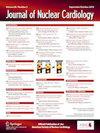Post-walking exercise skeletal muscle perfusion and energetics in patients with symptomatic lower extremity peripheral artery disease
IF 3
4区 医学
Q2 CARDIAC & CARDIOVASCULAR SYSTEMS
引用次数: 0
Abstract
Background
The pathophysiology of symptoms and reduced exercise capacity from peripheral artery disease (PAD) remains unclear. Additionally, there is limited information on blood flow and skeletal muscle energetics after walking exercise in patients with claudication in comparison to healthy individuals.
Methods
We prospectively enrolled 19 patients with claudication from PAD and 12 healthy subjects. All participants underwent rest and post-exercise perfusion imaging of the lower leg muscles via PET/CT. Participants exercised on a treadmill following the Gardner-Skinner protocol. Skeletal muscle blood flow (SMBF) was quantified in each leg at rest and immediately after exercise. Phosphocreatine (PCr) recovery and NAD+/NADH concentrations were measured pre- and post-exercise by 31P magnetic resonance spectroscopy (MRS) in a subset of participants. Comparisons were made between the legs of healthy subjects and the asymptomatic and symptomatic legs of patients with PAD.
Results
SMBF increased post-exercise in all participants. Among patients with PAD, the post-exercise/rest SMBF ratio, was higher in the symptomatic (n = 25) than asymptomatic (n = 13) legs (8.03 ± 2.84 vs 6.03 ± 2.81, P = 0.046) and higher than the post-exercise/rest SMBF ratio measured in the legs of healthy subjects (4.40 ± 1.47, P < 0.001). The post-exercise/rest PCr and NAD+/NADH ratios were lower in the legs of patients with PAD (n = 3) when compared with the legs of healthy subjects (n = 6) (0.79 ± 0.06 vs 1.00 ± 0.07 (P = 0.004) and 1.15 ± 0.43 vs 2.08 ± 0.30 (P = 0.007), respectively).
Conclusions
SMBF increased post-exercise to the greatest degree in the symptomatic legs of patients with PAD and post-exercise skeletal muscle mitochondrial function was abnormal in patients with PAD. These data suggest that the causes of symptoms and reduced exercise capacity from PAD are not limited to abnormal perfusion pressure in the legs.

症状性下肢外周动脉疾病患者步行运动后骨骼肌灌注和能量学
背景:外周动脉疾病(PAD)引起的症状和运动能力降低的病理生理机制尚不清楚。此外,与健康人相比,关于跛行患者步行运动后的血流和骨骼肌能量的信息有限。方法:我们前瞻性地招募了19例PAD跛行患者和12名健康受试者。所有参与者均通过PET/CT进行休息和运动后下肢肌肉灌注成像。参与者按照加德纳-斯金纳方案在跑步机上锻炼。在休息和运动后立即测量每条腿的骨骼肌血流量(SMBF)。在一部分参与者中,通过31P磁共振波谱(MRS)测量运动前和运动后的磷酸肌酸(PCr)恢复和NAD+/NADH浓度。将健康受试者的腿与无症状和有症状的PAD患者的腿进行比较。结果:所有参与者运动后的SMBF均有所增加。患者垫、运动后/ rest SMBF比率,在症状(n = 25)高于无症状(n = 13)腿(8.03±2.84和6.03±2.81,p = 0.046),高于运动后/休息SMBF比率测量腿的健康受试者(4.40±1.47,p + / NADH比率较低的腿垫(n = 3)患者与健康受试者的腿相比(n = 6)(0.79±0.06和1.00±0.07 (p = 0.004)和1.15±0.43和2.08±0.30 (p = 0.007),分别)。结论:运动后SMBF在PAD患者有症状的腿部增加最大,PAD患者运动后骨骼肌线粒体功能异常。这些数据表明,PAD的症状和运动能力降低的原因并不局限于腿部灌注压异常。
本文章由计算机程序翻译,如有差异,请以英文原文为准。
求助全文
约1分钟内获得全文
求助全文
来源期刊
CiteScore
5.30
自引率
20.80%
发文量
249
审稿时长
4-8 weeks
期刊介绍:
Journal of Nuclear Cardiology is the only journal in the world devoted to this dynamic and growing subspecialty. Physicians and technologists value the Journal not only for its peer-reviewed articles, but also for its timely discussions about the current and future role of nuclear cardiology. Original articles address all aspects of nuclear cardiology, including interpretation, diagnosis, imaging equipment, and use of radiopharmaceuticals. As the official publication of the American Society of Nuclear Cardiology, the Journal also brings readers the latest information emerging from the Society''s task forces and publishes guidelines and position papers as they are adopted.

 求助内容:
求助内容: 应助结果提醒方式:
应助结果提醒方式:


